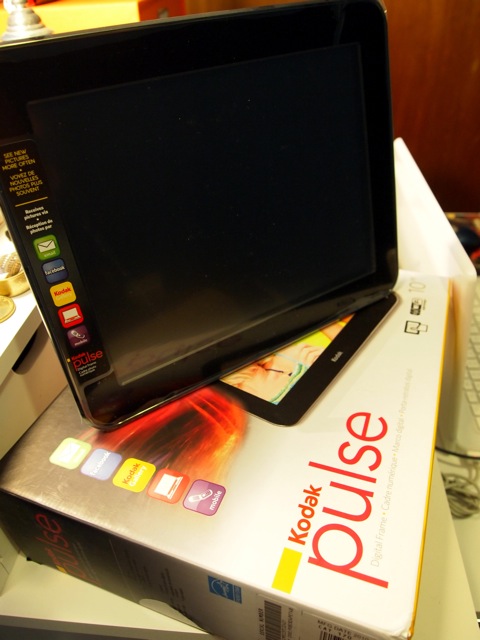Hands-on review: Kodak Pulse digital photo frame

There are a ton of new digital photo frames out on the market, so here's the lowdown on at least one to make the search a bit less daunting. Let's take a closer look at the recently released Kodak Pulse.
SET-UP
The Kodak Pulse isn't hard to figure out, but thankfully there's a large-print and short manual with diagrams included in the box. After plugging the included power adapter into device and into the wall, the Pulse should turn on. If not, there is a large power button on the back that should do the job.
After that, you'll have to complete some basic tasks like setting the language, connecting to your home (or office) wireless network, and obtaining a security code for your personal frame. At this point, you'll have to activate your digital picture frame online using that code.
For me, using the touchscreen interface was simple and not sluggish at all. The only slow part was trying to connect to my home wireless network, but the blame there could definitely go to the router. Once I set up my own Kodak account and entered the activation code, this was immediately transmitted to the frame and it was ready for use.
Conveniently, the Pulse can be gifted easily and configured without having to take anything out of the box. On the side of the packaging, buyers will find a white label with an activation code, which can be entered at www.kodakpulse.com for setting this frame up before dropping it in the mail.
Note: The activation code displayed when registering the device using the on-screen demands is not the same as the one on the side of the box.
USE
Getting your photos up on the 10-inch LED-backlit display shouldn't be that difficult. Along with being able to make use of the USB 2.0 port and memory card slots hidden on the back side, you can upload photos to your Kodak account at www.kodakpulse.com and have them sent for showing. Supported media cards include SD/SDHC, MMC, MS/MS PRO/MS PRO Duo, and xD.
Even more uniquely is the fact that this digital photo frame comes with its own e-mail address, to which you can email photos from your computer or smartphone for sharing on-the-go. There is 512 MB of internal memory to keep hold of these. You can also invite friends to see your gallery or send photos to the email address, but be careful as they will automatically go to the display. You wouldn't want anything in appropriate to suddenly appear.
And if all that wasn't enough, you can grab shots from Facebook too.
I sampled photos with my SD card first using a small group of test photos. The images on the card instantly popped up on full screen display. I instantly learned that if you have a portrait-angle photo, it's not always going to be positioned correctly automatically, so you'll have to do that yourself on your computer first.
It's easy to stop and start the slide transition by just tapping on the screen, which will also bring up a large-button user interface. After I got bored with seeing the same few photos pop up in either full screen or collage form while playing around with the controls, I uploaded a few from my computer to the Kodak Gallery.
Unfortunately, getting images from the Kodak Gallery wasn't so instant. After adding them to my personal Kodak account, it took several minutes for them to start appearing
Users can choose to have the images displayed full screen or as part of a collage. Naturally, photos can be set into a digital slideshow. Gone are the days of showing of family vacation photos on a rusty slide projector.
But overall, the picture quality was more than satisfactory, even if it wasn't as crisp as a printed hi-res photo. For reference, some of the specs on this mercury-free panel include an 800 x 600 resolution and 4:3 aspect ratio. What is really special about this display is just how many ways you can share photos with the display and how easy it is to set up.
AVAILABILITY
Ready for the taking, the Kodak Pulse has an MSRP of $199.95. Digital frames are going to be costly for a long time to come, and if you just want something more budget-friendly, there are smaller and cheaper options available.
But if you're in the market for a higher-end model, then the Kodak Pulse could be a good way of displaying those photos from your summer vacation at your holiday party this winter given how simple it is to share and get your photos to the screen.
